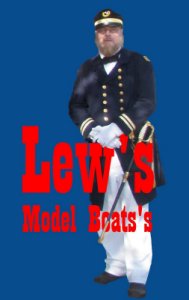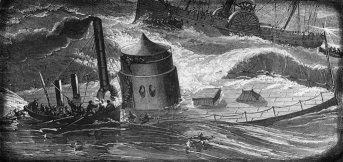
|
Welcome to - Lew's Model Boats - and more! |
go to Home Page |
| LewsModelBoats.org is not a commercial web site. Lew is a scale model builder/hobbiest (model boats and more). Views on this web site are opinions of the author and not driven by any commercial entity. Opinions are welcome - by mailing Lew (see contacts). © Copyright 2024 Lew's Model Boats. Disclosure: This Lews Model Boats do not have any financial ties to any company, political affiliation nor any other subsidy and has no gains from these and any other person(s). Lews Model Boats and this site is purely for the enjoyment of its viewers and others who enjoy this hobby. |

The U.S.S. Monitor and the C.S.S. Virginia made history on March 9, 1862 when they became the first ironclad warships to engage in combat against each other. The U.S.S. Monitor revolutionized warship designs in many way, most notably in having a rotating armored gun turret. The name "Monitor" then became a description or class of turreted ironclads to follow.
As such, the U.S.S. Monitor lends itself to being modeled. Several manufacturers have produced small scale models of the U.S.S. Monitor, leaving larger scale models, especially those radio controlled, to the scratch model builder.
Relatively few have built a larger scale model of the U.S.S. Monitor. Perhaps one of the reasons is finding well documented plans. As the original ship was built rapidly on a tight schedule, a significant portion of the ship's actual construction deviated from the plans for one reason or another. Much of the actual design has been and continues to be uncovered as NOAA and the Mariners' Museum restores much of the original U.S.S. Monitor's components and old documentation is released and exchanged.
Another reason that might drive modelers away from building an operating scale model of the USS Monitor is the low freeboard. The original ship had a freeboard (the distance edge of the deck is above the water) of only 18-inches when fully loaded with coal, water, supplies, and munitions. At 54mm the freeboard distance equates to only 9/16 of an inch. This will be discussed later.
Super detailing includes showing the seams in the armor joints, bolts, nuts, rivets, almost down to the seams in the canvas canopy. Weathering is definitely recommended. Also, a great addition to a model is having crew members, as well as flags, and perhaps tools and other items to fill the scene.

The builder and author (now retired) was an Equipment Designer for several large corporations which subcontracted for the government. As ab equipment designer, he designed a significant amount of test equipment chambers and fixturing. Some had to be liquid tight (usually freons and oils) and some had to contain explosives used in destructive testing. Common materials used in fixturing and test compartments included the metals: Steel (various types), brass, copper, and aluminum. Plastics included: Plexiglass, Lexan, Teflon, Delrin, phenolics and numerous others.
Configurations ((which time period is modeled?)
The U.S.S. Monitor can be built to several configurations, and the modeler should not this important detail. The ship can be built as the original configuration: This is the way the ship looked as built up until the March 9, 1862 battle at Hampton Roads with the C.S.S. Virginia. During the battle, the Monitor suffered scars (dents) that stayed with her during her life afloat.
Another alternative is the way the Monitor looked post battle which would include the dents and damage from the battle. After the battle, the U.S.S. Monitor was modification at the Washington Navy yard. Most noticeable was the new sloping shield around the pilot house, on which work started on March 13,1862.
The Monitor also suffered more damage from the Confederate fortification at Drewry's Bluff on the James River. This would be reflected in the period after the action there on May 15, 1862.
The Monitor arrives at the Washington Navy Yard under tow on October 3, 1862. Several weeks are spent repainting, repairing, and modifying the vessel. A telescoping smoke stack and taller ventilator boxes are added; davits and cranes are installed for hoisting the ship's new boats. Battle damage is repaired with iron patches, and each scar is labeled according to its origin: "Merrimac," "Minnesota," "Ft. Darling," "Merrimac's Prow." In
 November & December 1862, the Monitor is back on
blockading duty in Hampton Roads. A rifle screen has been added to
the top of the turret. Made of 1-inch-thick boiler plate, it affords
those on top of the turret protection from musket fire.
November & December 1862, the Monitor is back on
blockading duty in Hampton Roads. A rifle screen has been added to
the top of the turret. Made of 1-inch-thick boiler plate, it affords
those on top of the turret protection from musket fire.The image at the right is almost comically drawn, but is showing the sinking of the Monitor on the night of December 31, 1862. A close look shows the sloping pilot house, branched smokestack, extended vent stacks, and the plate around the top of the turret just beneath the canopy.